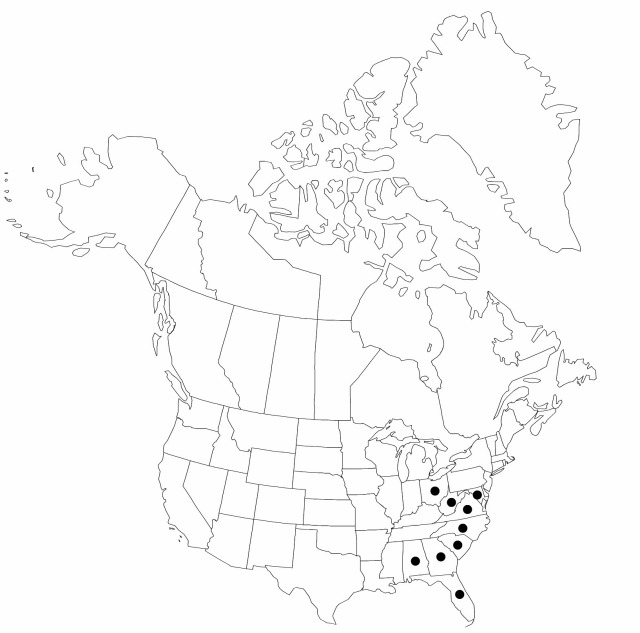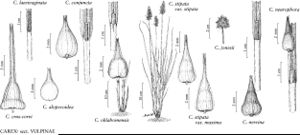familyCyperaceae
genusCarex
sectionCarex sect. Vulpinae
speciesCarex stipata
varietyCarex stipata var. maxima
Carex stipata var. maxima
Ill. Carex, 122, plate 391. 1862.
IllustratedEndemic
Synonyms: Carex stipata var. uberior C. Mohr Carex uberior
Treatment appears in FNA Volume 23.
Culms to 120 cm × 7 mm. Leaf-blades glaucous, to 100 cm × 8–15 mm. Inflorescences to 15 × 4 cm. Perigynia to 5–6 × 2 mm; beak 3–3.5 mm.
Phenology: Fruiting Apr–Jun.
Habitat: Seasonally saturated or inundated soils in wet meadows, marshes, edges of tidal marshes, cypress swamps, or alluvial bottomlands
Elevation: 0–1500 m
Distribution
Loading map...

Ala., Fla., Ga., Md., N.C., Ohio, S.C., Va., W.Va.
Discussion
Carex stipata var. maxima replaces Carex stipata var. stipata in the southern parts of its range and is distinguished by its larger size, longer perigynia, and longer beaks.
Selected References
None.
Lower Taxa
None.
"shortened" is not a number.
... more about "Carex stipata var. maxima"
ovate +
smaller +
0mm;1.5mm +
basifixed +
not erose +
colorless +
contracted +
fragile +
glabrous +
convex +
membranous +
not persistent +
serrulate +
not epistomic +
absent +
v--shaped +
leaflike +
1;many +
distinguishable +
15;25 +
glabrous +
scabrous +
compressed +
basal +
abundant +
single +
unisexual +
veined +
rugose +
Seasonally saturated or inundated soils in wet meadows, marshes, edges of tidal marshes, cypress swamps, or alluvial bottomlands +
Present +
spicate +
pseudoumbel +
modified +
androgynous +
glaucous +
8mm;15mm +
absent +
acute +
free +
0mm;0.8mm +
fused +
angled +
distinct +
arranged +
falling +
absent +
with - 1-3-6 - -30 bristles and/or scales +
thin +
pale-brown +
2-3 - -4-carpellate +
fused +
pistillate +
subtending +
sheathless +
scale-like;filiform +
pistillate +
Ill. Carex, +
1862 +
arranged +
adventitious +
fibrous +
empty +
hyaline +
1;0;1 +
fertile +
2-keeled +
cylindric +
arranged +
4;20 +
1-flowered +
distinct +
papillate +
undivided +
persistent +
cylindric +
deciduous +
2-3 - -4-fid +
Carex stipata var. maxima +
Carex stipata +
variety +
androgynous +
free +
thin +
spongy +
redbrown +
short-rhizomatous +
perennial +
